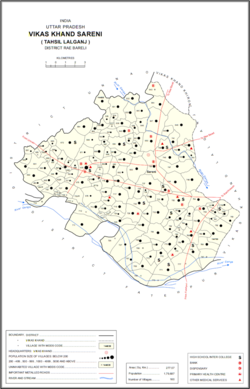Pasan Khera is a village in Sareni block of Rae Bareli district, Uttar Pradesh, India.[2] It is located 13 km from Lalganj, the tehsil headquarters.[3] As of 2011, it has a population of 671 people, in 99 households.[2] It has no healthcare facilities and does not host a weekly haat or a permanent market.[2] It belongs to the nyaya panchayat of Malkegaon.[4]
Pasan Khera
Pāsan Khera | |
|---|---|
Village | |
 Map showing Pasan Khera (#753) in Sareni CD block | |
| Coordinates: 26°06′08″N 80°51′14″E / 26.102101°N 80.853914°E[1] | |
| Country | |
| State | Uttar Pradesh |
| District | Raebareli |
| Area | |
| • Total | 0.484 km2 (0.187 sq mi) |
| Population (2011)[2] | |
| • Total | 671 |
| • Density | 1,400/km2 (3,600/sq mi) |
| Languages | |
| • Official | Hindi |
| Time zone | UTC+5:30 (IST) |
| Vehicle registration | UP-35 |
The 1951 census recorded Pasan Khera as comprising 1 hamlet, with a total population of 233 people (116 male and 117 female), in 45 households and 36 physical houses.[5] The area of the village was given as 114 acres.[5] 29 residents were literate, 26 male and 3 female.[5] The village was listed as belonging to the pargana of Sareni and the thana of Sareni.[5]
The 1961 census recorded Pasan Khera as comprising 1 hamlet, with a total population of 269 people (134 male and 135 female), in 46 households and 40 physical houses.[6] The area of the village was given as 114 acres.[6]
The 1981 census recorded Pasan Khera as having a population of 425 people, in 73 households, and having an area of 46.14 hectares.[3] The main staple foods were given as wheat and rice.[3]
The 1991 census recorded Pasan Khera (as "Vasan Khera") as having a total population of 472 people (247 male and 225 female), in 72 households and 72 physical houses.[4] The area of the village was listed as 46 hectares.[4] Members of the 0-6 age group numbered 71, or 15% of the total; this group was 51% male (36) and 49% female (35).[4] Members of scheduled castes made up 29% of the village's population, while no members of scheduled tribes were recorded.[4] The literacy rate of the village was 51% (165 men and 76 women).[4] 107 people were classified as main workers (93 men and 14 women), while 0 people were classified as marginal workers; the remaining 365 residents were non-workers.[4] The breakdown of main workers by employment category was as follows: 39 cultivators (i.e. people who owned or leased their own land); 41 agricultural labourers (i.e. people who worked someone else's land in return for payment); 0 workers in livestock, forestry, fishing, hunting, plantations, orchards, etc.; 0 in mining and quarrying; 0 household industry workers; 7 workers employed in other manufacturing, processing, service, and repair roles; 0 construction workers; 10 employed in trade and commerce; 0 employed in transport, storage, and communications; and 10 in other services.[4]
References
edit- ^ "Geonames Search". Do a radial search using these coordinates here.
- ^ a b c d e "Census of India 2011: Uttar Pradesh District Census Handbook - Rae Bareli, Part A (Village and Town Directory)" (PDF). Census 2011 India. pp. 262–87. Retrieved 23 October 2021.
- ^ a b c Census 1981 Uttar Pradesh: District Census Handbook Part XIII-A: Village & Town Directory, District Rae Bareli (PDF). 1982. pp. 146–7. Retrieved 23 October 2021.
- ^ a b c d e f g h Census 1991 Series-25 Uttar Pradesh Part-XII B Village & Townwise Primary Census Abstract District Census Handbook District Raebareli (PDF). 1992. pp. xxiv–xxviii, 178–9. Retrieved 23 October 2021.
- ^ a b c d Census of India, 1951: District Census Handbook Uttar Pradesh (42 - Rae Bareli District) (PDF). Allahabad. 1955. pp. 116–7. Retrieved 23 October 2021.
{{cite book}}: CS1 maint: location missing publisher (link) - ^ a b Census 1961: District Census Handbook, Uttar Pradesh (39 - Raebareli District) (PDF). Lucknow. 1965. pp. lxxiv-lxxv of section "Dalmau Tahsil". Retrieved 23 October 2021.
{{cite book}}: CS1 maint: location missing publisher (link)
